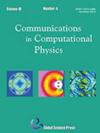用混合 WENO-AO 方法解决欧拉和纳维-斯托克斯问题的高效高阶气体动力学方案
IF 2.6
3区 物理与天体物理
Q1 PHYSICS, MATHEMATICAL
引用次数: 0
摘要
高阶气体动力学方案(HGKS)具有良好的鲁棒性、较高的效率和令人满意的精度,其性能可与 WENO-AO(自适应阶次的 WENO)方案相结合进一步提高重构性能。为了降低重构过程中的计算成本,本文建议将 HGKS 与混合 WENO-AO 方案相结合。如果目标变量的重构多项式的所有极值点都在大模版之外,则混合 WENO-AO 方案直接使用上风线性近似来重构这些变量。否则,将使用 WENO-AO 方案。与将混合 WENO 方案与传统黎曼求解器相结合不同,混合 WENO-AO 方法的困扰单元指标在 HGKS 的空间重构过程中得到了充分利用。在法向和切向重构过程中,气体动力学方案通量不仅需要重构左右界面上的保守变量,还需要重构保守变量的导数项。通过减少 WENO-AO 方案的使用次数,可以降低计算成本。采用 WENO-AO 混合方法的高阶气体动力学方案保留了 WENO5-AO GKS 的原有稳健性和精确性,同时表现出更高的计算效率。本文章由计算机程序翻译,如有差异,请以英文原文为准。
An Efficient High-Order Gas-Kinetic Scheme with Hybrid WENO-AO Method for the Euler and Navier-Stokes Solutions
The high-order gas-kinetic scheme (HGKS) features good robustness, high
efficiency and satisfactory accuracy,the performance of which can be further improved
combined with WENO-AO (WENO with adaptive order) scheme for reconstruction.
To reduce computational costs in the reconstruction procedure, this paper proposes
to combine HGKS with a hybrid WENO-AO scheme. The hybrid WENO-AO scheme
reconstructs target variables using upwind linear approximation directly if all extreme
points of the reconstruction polynomials for these variables are outside the large stencil. Otherwise, the WENO-AO scheme is used. Unlike combining the hybrid WENO
scheme with traditional Riemann solvers, the troubled cell indicator of the hybrid
WENO-AO method is fully utilized in the spatial reconstruction process of HGKS.
During normal and tangential reconstruction, the gas-kinetic scheme flux not only
needs to reconstruct the conservative variables on the left and right interfaces but also
to reconstruct the derivative terms of the conservative variables. By reducing the number of times that the WENO-AO scheme is used, the calculation cost is reduced. The
high-order gas-kinetic scheme with the hybrid WENO-AO method retains original robustness and accuracy of the WENO5-AO GKS, while exhibits higher computational
efficiency.
求助全文
通过发布文献求助,成功后即可免费获取论文全文。
去求助
来源期刊

Communications in Computational Physics
物理-物理:数学物理
CiteScore
4.70
自引率
5.40%
发文量
84
审稿时长
9 months
期刊介绍:
Communications in Computational Physics (CiCP) publishes original research and survey papers of high scientific value in computational modeling of physical problems. Results in multi-physics and multi-scale innovative computational methods and modeling in all physical sciences will be featured.
 求助内容:
求助内容: 应助结果提醒方式:
应助结果提醒方式:


